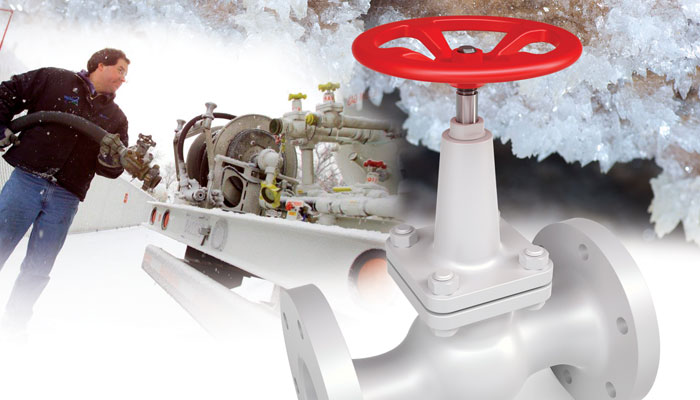All
Reinforcing the Supply Chain
by John MacKenna

Crestwood seeks approval for underground LPG storage
Domestic supplies of propane are plentiful, but logistical problems have created price and supply risks in the Northeast and Midwest that could haunt marketers and their customers in the event of another winter like the last one.
An increase in regional storage capacities would go a long way toward stabilizing supply and price in the constrained regions, according to the National Propane Gas Association (NPGA), but that is easier said than done.
One project that NPGA sees as critical for both regions is Crestwood Midstream Partners’ proposed 2.1 billion barrel LPG storage facility in Watkins Glen, in New York State’s Finger Lakes region. Crestwood would market propane that is produced in the nearby Utica and Marcellus shale regions, delivered mostly by the Enterprise TE Products (TEPPCO) Pipeline, and stored for winter use in underground salt caverns.
Gaps in the Supply Chain
The Northeast currently lacks the propane storage necessary to prevent price spikes during periods of elevated demand, and the existing delivery infrastructure cannot supply propane immediately to meet the need. Since propane is not produced in New York or New England, it must be transported into the region via the TEPPCO Pipeline or by trains, trucks and ships. The propane brought in by ships tends to be very expensive relative to U.S. production, because buyers must compete in the world market where prices are much higher.
Last winter, the gaps in the Northeast and Midwest propane infrastructure were exposed when demand rose due to heavy crop-drying demand in the Midwest followed by more than a month of widespread, severe cold weather. Crestwood has estimated that existing delivery constraints, together with increased propane exports, created an 81.4 million gallon propane shortfall in New York State alone. Forced to rely on higher-cost delivery alternatives, the average propane customer in New York State paid $411 more for propane than they would have if the Crestwood facility had been online, the company estimated. The combined cost burden on New Yorkers exceeded $100 million, according to Crestwood.
NPGA believes primary storage facilities like Crestwood’s provide essential flexibility in the supply chain. “A fundamental fact is that propane, like natural gas, is produced in basically the same amount every day all year long,” said Jeff Petrash, NPGA’s Vice President and General Counsel. “But in the non-petrochemical sectors it is consumed in a highly seasonal way, so what members do is to rationalize the difference between how it is produced and the way in which it is consumed. Storage is a critical way of doing that. Storage can also fundamentally replace increasing the size of pipelines and other infrastructure. It really is critical.”
The geographic location makes the Finger Lakes facility particularly important, because it can work as a reserve for New York, New England and, to a lesser extent, Pennsylvania and the Mid-Atlantic region, according to the NPGA executive. During last year’s brutal winter, the Crestwood facility would also have taken pressure off storage facilities such as Marysville, Mich., and Sarnia, Ontario, that principally serve the Midwest. Other options to the west of Finger Lakes are limited because there are few if any areas of underground salt deposits similar to upstate New York, Petrash said.
For customers in New England, the Finger Lakes facility could have reduced LPG costs considerably. “Even in last winter, which was one of the highest demand winters ever, Crestwood is large enough to have offset every gallon of propane imported from Europe and Africa,” said Joe Rose, President of the New England Propane Gas Association (NEPGA). Suppliers imported more than 70 millions gallons last winter and sold it for about $1 more per gallon than domestic propane. “We paid a large premium for that, so it cost the citizenry, by not having Crestwood available, about $70 million last winter.”
The Finger Lakes facility is particularly attractive to marketers in New England, because it is on the TEPPCO pipeline, so product reserved in the Watkins Glen salt caverns can be picked up at Selkirk, N.Y., Rose said.
Approval Is a Challenge
While the region-wide benefits of improved propane storage are apparent, local political considerations can be a formidable obstacle to permitting, particularly in the Northeast. Thousands of homes in New York and every neighboring state depend on propane for winter heating, but homeowners – and their retail propane suppliers – generally stay out of the public debate over new energy facilities.
Instead, the permit application process becomes a forum for environmentalists and advocates of competing energy sources to press their agendas and build support for their causes. Regional propane projects like Crestwood’s are particularly vulnerable in this process, because the permitting bodies are generally at the state and local levels. As such, they tend to be highly responsive to aggressive public input and impervious to regional considerations from beyond their immediate jurisdictions.
Crestwood’s experience since it first applied for permits in 2009 is familiar to numerous energy suppliers who have sought to build or expand their facilities, including terminal operators in South Portland, Maine, and propane wholesalers in Newington, N.H., and Clinton, Conn.
NPGA’s Petrash believes the energy industry, from utilities to independent marketers, has performed so reliably through the years that customers do not appreciate the need for energy infrastructure. “The overarching issue is that people want their furnace and their flat panel TV, but then they don’t want the infrastructure that is essential to deliver that. This is a cross-cutting issue across all energy sources. The energy business has been so successful that it is beyond people’s imaginations. They think it’s automatic. The thermostat works, and you stay warm, and homeowners have no clue of the massive, complex infrastructure behind that.”
The pattern has been repeated in the Finger Lakes region, with Crestwood coming up against a coalition known as Gas Free Seneca (GFS), which formed in 2011 to oppose the underground storage plan. Drawing its support largely outside the Finger Lakes region, GFS has aggressively opposed the proposed facility by packing public hearings and exploiting the permitting process to delay the project. In 2013, pro-environment law firm Earthjustice agreed to represent GFS. The groups have lately recruited the Finger Lakes region’s wine growers in its public relations campaign, suggesting that gas storage would be incompatible with wine tourism.
Despite the opposition, Crestwood received a Nationwide Permit from the U.S. Army Corps of Engineers in 2012 certifying the project as having minimal environmental impact. (The storage facility would be located at Crestwood’s US Salt complex, which currently supports salt production and natural gas storage operations today.) Final say on the project rests with the New York State Department of Environmental Conservation (DEC), however, and that has proved a very difficult hurdle to clear.
Five Years and Counting
After two public hearings in 2011, Crestwood offered several voluntary concessions on the project scope in the hope of finally winning the elusive Underground Storage Permit (USP) from the DEC. The company reduced the project’s environmental footprint by reducing total brine pond capacity and modifying brine pond configurations to replace one large brine pond with two smaller ones farther from Seneca Lake. (See sidebar for more on salt cavern storage.)
The company also offered to supplement the project’s design to ensure it achieved more rigorous standards applicable to dams (for the brine ponds) and landfills (for the brine pond liners). These changes were later incorporated into the final design plans submitted to the DEC in September 2012. Crestwood also commissioned and published a Quantitative Risk Analysis for the LPG storage operations, using a professional risk assessment firm recommended by GFS. Finally, the company conducted water supply well survey and groundwater monitoring well sampling.
In late 2012, Crestwood submitted its final Stormwater Pollution Prevention Plan and final Engineer’s Report and Drawings to DEC and worked with DEC staff with the hope of securing the permit in the first half of 2013.
Momentum seemed to be building in 2013 and 2014, as one promising step followed another.
- New York’s State Geologist signed off on the project in March 2013, fulfilling the last procedural requirement necessary for DEC to publish the Final Supplemental Environmental Impact Statement (FSEIS).
- In May 2013, the Federal Energy Regulatory Authority (FERC) approved a separate proposal to expand Crestwood’s Seneca Lake natural gas storage facility. The caverns used to store natural gas are located in the same formation as, and have similar characteristics to, the caverns Crestwood proposes to convert into LPG storage. In doing so, FERC worked with DEC and rejected arguments made by GFS and Earthjustice that echoed arguments the groups had made to the DEC as part of the Finger Lakes permitting process.
- In June 2014, the Schuyler County Legislature – the governing body of the project’s “home” county – passed a resolution supporting the project and calling on the DEC to publish the FSEIS and issue the USP.
- In July 2014. DEC Commission Joseph Martens indicated in writing that the DEC had everything it needed to make a decision on the project this year.
- In August 2014, the United Steel Workers announced their support for the project.
Just when it appeared the five-year wait might be at an end, New York Governor Andrew Cuomo reopened the application process and directed the DEC to give the opposition another opportunity to voice their concerns. DEC will apparently punt the project to an Administrative Law Judge to decide whether there are any “significant issues” outstanding that should be resolved through an adjudicatory process. It is not known how long that process will take, so the project remains in a holding pattern. Once a permit is granted, Crestwood officials say the project will require about six months of construction before going online.
Marketers Can Help
Trade associations including NPGA and NEPGA have lobbied in support of Crestwood’s USP application, and they plan to continue their efforts until the facility is approved. NEPGA’s Rose said he has attended a public hearing, participated in a joint press conference with other associations, and organized a letter writing campaign. He has also spoken with some of the New England governors and Congressional delegations and encouraged them to discuss their constituents’ needs with Cuomo.
NPGA has also organized grassroots efforts on behalf of the Crestwood facility, such as contacting Members of Congress and Senators and asking them to reach out to Cuomo. The Association encourages industry participants who support the facility to participate as well. Industry participants who want to help support Crestwood’s project can email NPGA’s Peter Ferrell at pferrell@npga.org.
“It’s time to get off the dime and let this thing fly,” said Rose.
Related Posts
 The Possibilities of Renewable Propane
The Possibilities of Renewable Propane
Posted on March 13, 2024
 Propane Can Do That
Propane Can Do That
Posted on March 12, 2024
 Take Action and Take Control of Your Future at Industry Summit VI and Visions ‘24
Take Action and Take Control of Your Future at Industry Summit VI and Visions ‘24
Posted on March 11, 2024
Enter your email to receive important news and article updates.

